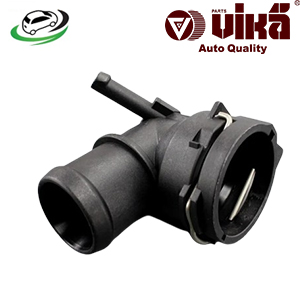Get Upper Radiator Coupler Volkswagen Jetta V TDI 1K0122291BA
The upper radiator coupler, sometimes known as the upper radiator hose or upper radiator connector, is a crucial component in a vehicle’s cooling system. It serves as a conduit between the engine and the radiator, facilitating the flow of coolant through the engine and radiator. This flow is essential for maintaining the engine at an optimal operating temperature. Understanding the design, function, benefits, and maintenance of the upper radiator coupler is key to ensuring a reliable and efficient cooling system.
Function and Importance
- Coolant Transportation: The primary function of the upper radiator coupler is to transport coolant from the engine to the radiator. As the engine runs, it generates heat that is absorbed by the coolant. The upper radiator coupler channels this heated coolant to the radiator, where it is cooled before being recirculated back into the engine.
- Temperature Regulation: Effective coolant flow through the upper radiator coupler helps regulate the engine’s temperature. By transferring hot coolant to the radiator, where it is cooled by air flow, the coupler ensures that the engine does not overheat, thus maintaining optimal performance and preventing engine damage.
- Prevention of Overheating: A properly functioning upper radiator coupler is crucial for preventing engine overheating. If the coupler is damaged or leaks, coolant flow can be disrupted, leading to overheating. This can cause severe engine damage, including warping, cracking, or even a complete engine failure.
Design and Construction
- Materials: Upper radiator couplers are typically made from materials designed to withstand high temperatures and pressure. Common materials include:
- Rubber: Most traditional radiator hoses are made from high-temperature rubber, which is flexible and resistant to heat and chemicals.
- Silicone: High-performance vehicles may use silicone hoses due to their superior heat resistance, durability, and flexibility.
- Metal: Some upper radiator couplers may include metal sections or be entirely metal, especially in high-performance or heavy-duty applications. Metal couplers are more durable but less flexible compared to rubber or silicone.
- Design: The design of the upper radiator coupler includes several key features:
- Shape and Size: The coupler is typically shaped to fit specific engine and radiator configurations, with precise diameters to match the engine and radiator inlet/outlet.
- Clamps and Connectors: The coupler is secured to the engine and radiator with clamps or connectors, which may be adjustable or designed for a specific fit.
- Seals and Gaskets: To ensure a tight fit and prevent leaks, the upper radiator coupler often includes seals or gaskets. These components help maintain a leak-proof connection between the hose and the engine or radiator.
Common Issues
- Leaks: Over time, the upper radiator coupler can develop leaks due to wear, degradation of materials, or improper installation. Leaks can lead to coolant loss, reduced cooling efficiency, and potential overheating.
- Cracks and Damage: Exposure to high temperatures, vibrations, and engine chemicals can cause the coupler to crack or become damaged. This can disrupt coolant flow and lead to engine overheating.
- Clogging: Although less common, debris or sediment in the cooling system can sometimes clog the coupler, restricting coolant flow and affecting engine temperature regulation.
- Wear and Tear: Regular engine vibrations and thermal cycling can cause wear and tear on the upper radiator coupler, leading to deterioration and potential failure over time.
Maintenance and Inspection
- Regular Inspections: Periodic inspections of the upper radiator coupler are essential for identifying potential issues. Look for visible signs of leaks, cracks, or damage. Check for coolant puddles under the vehicle, which may indicate a leaking coupler.
- Coolant System Maintenance: Regularly maintaining the cooling system can help prevent issues with the upper radiator coupler. This includes flushing the coolant system to remove debris and sediment, which can help prevent clogging and damage to the coupler.
- Clamp and Connector Checks: Ensure that clamps and connectors are secure and in good condition. Loose or damaged clamps can lead to leaks or disconnection of the coupler.
- Replacement: If the upper radiator coupler is found to be damaged, cracked, or leaking, it should be replaced promptly. Using a high-quality replacement coupler that matches the vehicle’s specifications is crucial for ensuring proper fit and function.
- Professional Inspection: For serious issues or if you’re unsure about the condition of the coupler, seek professional assistance. A mechanic can perform a thorough inspection and recommend necessary repairs or replacements.
Replacement and Repair
- Replacement: If the upper radiator coupler is severely damaged or worn out, replacement is the best option. Ensure that the new coupler matches the specifications of the original part and is installed correctly to maintain proper coolant flow and prevent leaks.
- Repair: Minor issues such as small leaks or loose clamps may sometimes be repaired. However, repairs are generally considered a temporary solution, and replacement is usually recommended for long-term reliability.
- DIY vs. Professional Help: For those with automotive experience, replacing or repairing the upper radiator coupler may be a feasible DIY project. However, for most vehicle owners, professional assistance ensures proper installation and avoids potential issues.
Follow us on Facebook for more parts.



